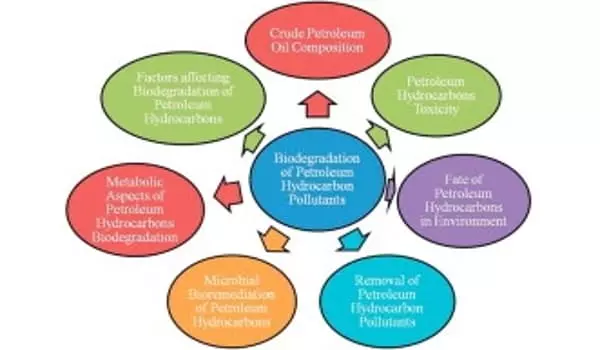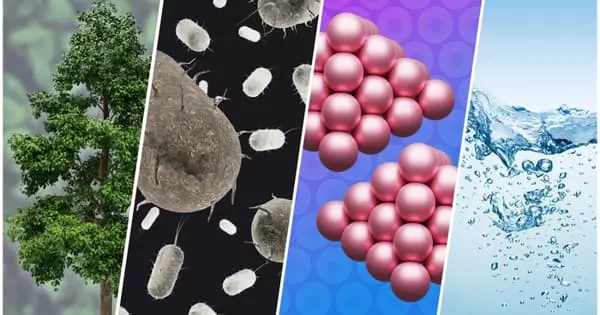The petrochemical industry converts oil and gas into precursors that are then used to create lubricants and other critical products. Chemists demonstrate that bacteria can be metabolically engineered to produce similar precursors, thereby providing a sustainable replacement for fossil fuels while using less energy. The microbes only require glucose. Their medium-chain hydrocarbons can be broken down into shorter chains and polymerized into plastics, or they can be lengthened to make products like diesel.
If the petrochemical industry is to wean itself off of oil and gas, it must find sustainably sourced chemicals that can be easily incorporated into existing processes for producing products like fuels, lubricants, and plastics.
The obvious option is to produce those chemicals biologically, but microbial products differ from fossil fuel hydrocarbons in two important ways: They have an excessive amount of oxygen, as well as an excessive number of other atoms clinging to the carbons. In order for microbial hydrocarbons to function in existing synthetic processes, they must often be de-oxygenated (or reduced in chemical terms) and stripped of extraneous chemical groups, which requires energy.
A group of chemists from the University of California, Berkeley, and the University of Minnesota has engineered microbes to produce hydrocarbon chains that can be deoxygenated more easily and with less energy – basically, just the sugar glucose that the bacteria eat, plus a little heat.
The process enables the microbial production of a wide range of chemicals currently produced from oil and gas, including lubricants made from medium-chain hydrocarbons, which have between eight and ten carbon atoms in the chain.
This process is one step toward deoxygenating these microbial products, and it enables us to begin making things that can replace petrochemicals, using only glucose from plant biomass, which is more sustainable and renewable. In this way, we can avoid petrochemicals and other fossil fuels.
Professor Michelle Chang
“Part of the issue with moving to something like glucose as a feedstock for making molecules or driving the chemical industry is that the fossil fuel structures of petrochemicals are so different — they’re usually fully reduced, with no oxygen substitutions,” said Michelle Chang, a UC Berkeley professor of chemistry and chemical and biomolecular engineering. “Bacteria, like all natural products, know how to make all these complex molecules with all these functional groups sticking out from them, but making petrochemicals that we’re used to using as precursors for the chemical industry is a bit of a challenge for them.”
“This process is one step toward deoxygenating these microbial products, and it enables us to begin making things that can replace petrochemicals, using only glucose from plant biomass, which is more sustainable and renewable,” she explained. “In this way, we can avoid petrochemicals and other fossil fuels.”
The bacteria were engineered to produce medium-length hydrocarbon chains, which had not previously been achieved, despite the fact that others had developed microbial processes for producing shorter and longer chains, up to about 20 carbons. However, Chang claims that the process can be easily adapted to produce chains of various lengths, including short-chain hydrocarbons used as precursors to the most common plastics, such as polyethylene.
Her findings were published in the journal Nature Chemistry by she and her colleagues.

A bioprocess to make olefins
Fossil hydrocarbons are simple linear chains of carbon atoms, each with a hydrogen atom attached. However, the chemical processes optimized for converting these into high-value products do not easily allow substitution by oxygenated microbially produced precursors with many other atoms and small molecules.
Chang and her colleagues, including former UC Berkeley postdoctoral fellows Zhen Wang and Heng Song, searched databases for enzymes from other bacteria that can synthesize medium-chain hydrocarbons in order to get bacteria to produce something that can replace these fossil fuel precursors. They were also looking for an enzyme that could add a special chemical group, carboxylic acid, to one end of the hydrocarbon, converting it to a fatty acid.
In total, the researchers inserted five different genes into E. coli bacteria, forcing the bacteria to ferment glucose and produce the desired medium-chain fatty acid. The added enzymatic reactions were independent of, or orthogonal to, the bacteria’s own enzyme pathways, which worked better than attempting to modify the bacteria’s complex metabolic network.
“We discovered new enzymes that could synthesize these mid-sized hydrocarbon chains and were orthogonal to bacterial fatty acid biosynthesis. This allows us to run it independently, and it consumes less energy than the native synthase pathway “Chang explained. “The cells consume enough glucose to survive, but then you have your pathway chewing through all the sugar to get higher conversions and a high yield.”
That final step to produce a medium-chain fatty acid primed the product for easy conversion to olefins, which are precursors to polymers and lubricants via catalytic reaction.
The UC Berkeley group collaborated with the Minnesota group led by Paul Dauenhauer, who demonstrated that a simple acid-based catalytic reaction known as Lewis acid catalysis (named after famed UC Berkeley chemist Gilbert Newton Lewis) easily removed the carboxylic acid from the final microbial products, 3-hydroxyoctanoic and 3-hydroxydecanoic acids, to produce the olefins heptene and nonene. Lewis acid catalysis consumes far less energy than the redox reactions required to remove oxygen from natural products in order to produce pure hydrocarbons.
“The biorenewable molecules created by Professor Chang’s group were ideal raw materials for catalytic refining,” Dauenhauer said, referring to these precursor molecules as bio-petroleum. “Because these molecules contained just enough oxygen, we were able to easily convert them to larger, more useful molecules using metal nanoparticle catalysts. This allowed us to fine-tune the distribution of molecular products as needed, just like traditional petroleum products, except that we were using renewable resources this time.”
Heptene (seven carbons) and nonene (nine carbons) can be used directly as lubricants, cracked to smaller hydrocarbons and used as precursors to plastic polymers such as polyethylene or polypropylene, or linked to form even longer hydrocarbons such as those found in waxes and diesel fuel.
“This is a general process for making target compounds, regardless of chain length,” Chang explained. “And you don’t have to engineer an enzyme system every time you want to change a functional group, the length of the chain, or the degree of branching.”
Despite their metabolic engineering accomplishment, Chang noted that the long-term and more sustainable goal would be to completely redesign processes for synthesizing industrial hydrocarbons, including plastics, so that they are optimized to use the types of chemicals that microbes normally produce, rather than modifying microbial products to fit into existing synthetic processes.
“There’s a lot of interest in the question, ‘What if we look at completely new polymer structures?” she explained. “Can we make monomers from glucose through fermentation for plastics with properties similar to those we use today, but not the same structures as polyethylene or polypropylene, which are difficult to recycle?”





